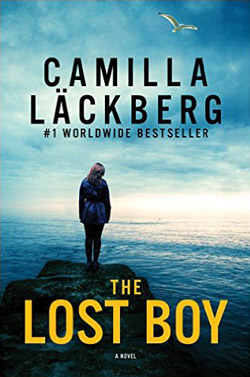 The Lost Boy by Camilla Läckberg ensnares Detective Patrik Hedstrom in a confounding new murder case in this Swedish psychological thriller (Available October 4, 2016).
The Lost Boy by Camilla Läckberg ensnares Detective Patrik Hedstrom in a confounding new murder case in this Swedish psychological thriller (Available October 4, 2016).
When I think of ghost stories that have left an impression, I immediately go to The Haunting of Hill House (1959) by Shirley Jackson and the film The Others (2001). Neither frightened me per se—I’ve yet to find a book or film in the genre able to induce such an effect, maybe because the real world has already covered that base—it’s more the tension and anxiety.
Ms. Jackson was able to command it with the right choice of words and turns of phrase, both with precision and force. I can still see the house, the road, and that out-of-control vehicle in the final moments. Etched forevermore. The Others, starring Nicole Kidman as a mother with two young children in a remote country house, floored me with its superb acting and twist ending.
I mention all that to show the standard I have for reading similar excursions and for one particular point: The Others is described as a “supernatural gothic horror film with elements of psychological horror”; Hill House’s genre is “gothic fiction.” But as I began reading The Lost Boy, I noted that it will be found under crime fiction at your local bookseller. Call it what you want, but when I’m hit with “I see dead people,” that equates to a simple, good old-fashioned ghost story. Plain and simple.
In The Lost Boy, Emelie is leaving Fjällbacka harbor with her husband Karl, circa 1870, heading to Gråskär, where he will be the new lighthouse keeper on the island. Her buoyant demeanor is soon sapped by a woman who says locals don’t refer to it as Gråskär.
“Is that right?” Emelie had the feeling that she really shouldn't ask, but her curiosity got the better of her. “So what do you call it then?”
At first the old woman didn't reply. Then she lowered her voice and said, “In these parts we call it Ghost Isle.”
“Ghost Isle?” Emelie's nervous laughter had carried over the water in the early morning haze. “How strange. Why?”
The old woman's eyes glittered when she spoke. “Because it's said that those who die out there never leave the island.”
The book periodically jumps back to the 19th century, and those passages are by far the most compelling. But Ms. Läckberg begins the proceedings during our era with a mother named Nathalie hustling her sleeping son, Sam, into a car. Her hands are bloody, she’s in flight, heading toward the same island as Emelie.
We get the slow reveal as to what happened to her husband and why she’s stealing away like a thief in the night. Nathalie had grown up on Ghost Isle. Almost immediately, she bumps into the parents of a man named Matte, who she once dated. (She had eventually married another man named Fredrik and gave birth to Sam.) At first, she takes comfort in her old boyfriend—and her family’s house. In a contrast to Emelie, she relishes the comfort of the nether world:
She had heard them in the night. The same whispering, the same voices that she recalled from when she was a child. Her watch told her that it was three A.M. when she awoke. At first she didn’t know what had caused her to wake up. Then she heard them. They were talking downstairs. A chair scraped. What did the dead talk about with each other? About things that had happened before they died? Or about what was taking place now, many years later?
Meanwhile, a murder has happened—after all, this is crime fiction—and Patrik Hedström is called in to investigate. Also involved is his wife Erica, which appears to be a recurring theme in this series. Regardless, they make a nice updated and expanded, gritty McMillan & Wife of sorts, though with twin sons and a daughter to look after. A subplot revolves around Erica's concern about her sister Anna’s suffering over the death of a child—and tons of other family filler.
Which brings me to The Lost Boy’s gargantuan length—with all the padding, it could have been shorter. I tackled the 497 pages with a frown, wondering where I could take a red pen to it to shorten the tome by a couple of hundred párrafos. Nonetheless, topnotch writing and plot makes wading through some of the drawn-out bits more bearable.
To learn more or order a copy, visit:
David Cranmer is the publisher and editor of BEAT to a PULP. Latest books from this indie powerhouse include the alternate history novella Leviathan and sci-fi adventure Pale Mars. David lives in New York with his wife and daughter.

The length of this one definitely puts me off. I read her first in this series, THE ICE PRINCESS, and it was effective. Winter in Scandanavia, murder, good characterization and likeable central characters and much tighter than what THE LOST BOY sounds like.
Scott, fans of this series will enjoy and should take a look. As a matter of fact, I’m sure they will regardless of my lukewarm recommendation.
A newspaper profile ahead of the king’s 30th birthday noted that he had seemed “temporarily unsuited” for the rigours of Gordonstoun but added: “Nowadays, he pays tribute to Kurt Hahn’s tough training in self reliance and leadership.”